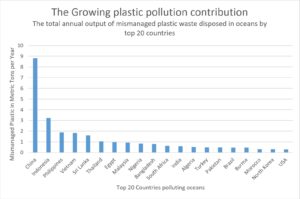Dec 05 2017
Plastic Waste
 I know, there are already so many things to worry about. It’s almost painful to hear about one more way in which we may be harming the world. Such reports are also often couched in emotional and dramatic terms.
I know, there are already so many things to worry about. It’s almost painful to hear about one more way in which we may be harming the world. Such reports are also often couched in emotional and dramatic terms.
However, it’s important to sift through the rhetoric and evaluate what the science says about what is actually going on. There is increasing reporting about the coming plastic apocalypse. We are dumping massive amounts of plastic into the environment, and some of that plastic is winding up in the world’s oceans. The world produced 343 million tons of plastic in 2014. Only 10% of that plastic was recycled. In total we have produced 8.3 billion metric tons of plastic, which does not biodegrade for hundreds of years.
The fact is, human civilization is big enough that we have to think about the effects of our massive industry. Producing that much plastic will likely have an impact on the environment. The biggest impact may be the percentage that winds up in the oceans – about 10%. Once there is just breaks down into smaller and smaller bits. Many animals accidentally eat the plastic, which can be fatal.
The good news is there are simple and effective ways to manage our plastic waste. The number one plastic polluter is China – almost 9 million metric tons of their plastic ends up on the ocean each year. The next country is Indonesia, with just over 3 million metric tons, followed by the Philippines, at just under two. The USA ranks 20th with less than 300 thousand million metric tons.
You may have noticed that there are countries with far bigger economies than Indonesia who produce far less plastic waste ending up in the ocean. The US still has the largest economy in the world (24%) with China second at 14.8%. So with a larger economy we dump 1/30th the plastic into the ocean as China.
This means that it is possible to properly manage our plastic waste. While the world average for recycling plastic is about 10%, the US is 28%. There is still a lot of room for improvement. But we also keep a larger portion of that plastic from getting into the ocean.
So what do we do? At the very least we need to bring all countries in line with average plastic management. The worst polluters need to make significant changes to the way they handle plastic, and that alone would make a dramatic improvement. That’s the low-hanging fruit.
But every country can do better. Recycling rates should be much higher. This is mainly about making it easy to recycle.
Companies can also evaluate what plastic they produce as part of their products and packaging, and consider ways to limit plastic and use more biodegradable materials.
There are lots of little things individuals can do as well. I actually find it easier to shop with large reusable bags, rather than carrying small plastic bags or fragile paper bags. That’s a win-win. I have also switched from using disposable plastic water bottles to a reusable water bottle. This ends up saving money – so again, a win-win.
Plastic is an extremely useful material. It is cost effective and practical for many applications. I’m not arguing that we should stop using it altogether. But it does have the feature of remaining in the environment for a long time, and findings its way into the ocean. So we just need to use it intelligently, to minimize waste down to a sustainable level.
We don’t need any major innovation or change in our economy. This problem is actually not that hard to fix, just by picking the low-hanging fruit.






